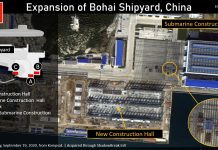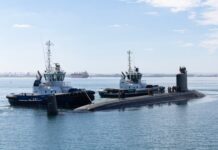
The U.S. industrial base must double its attack submarine output for America to meet its obligations under the AUKUS agreement with Australia and the United Kingdom, the Navy’s nominee to lead the Navy told Congress last week, US Naval Institute News reports.
[Also last week, the Australian Prim minister confirmed that Australia had paid the US a second payment of $A800 million under the AUKUS agreement to contribute to the US shipbuilding effort.]
Testifying before the Senate Armed Services Committee as part of his confirmation process to serve as the next chief of naval operations, Adm. Daryl Caudle praised Royal Australian Navy (RAN) submariners and said the current Pentagon-wide review of the AUKUS partnership is about U.S. industrial capacity.
“The question of Australia’s ability to conduct undersea warfare is not in question by me or by anyone,” Caudle told Sen. Tim Kaine (D-Va.), who chairs the SASC seapower subcommittee. “But as you know, the delivery pace is not where it needs to be to make good on the Pillar 1 of the AUKUS agreement, which is currently under review by our Defense Department.”
As of last month, the Pentagon is reevaluating AUKUS, which would see the U.S. share its nuclear propulsion technology for the second time in history, to ensure it aligns with the Trump administration’s priorities, USNI News previously reported. Elbridge Colby, the under secretary of defense for policy, is leading the assessment of the pact that could see the U.S. sell up to five Virginia-class attack boats to the RAN as an interim solution while it helps Australia develop an indigenous capability to maintain and build nuclear-powered attack submarines.
To sell the Virginia boats to the Australians, Navy officials have said the U.S. industrial base must build 2.33 attack boats per year while also keeping pace constructing one Columbia-class nuclear ballistic missile submarine each year. The industrial base currently builds about 1.3 attack boats per year.
Caudle agreed with SASC Chairman Sen. Roger Wicker (R-Miss.) that the U.S. Navy and the defense industrial base must pursue pivotal changes so General Dynamics Electric Boat and HII’s Newport News Shipbuilding can construct double the attack submarines they’re currently building.
“We do have to understand whether or not the industrial base can produce the submarines required so that we can make good on the actual pact that we made with the U.K. and Australia, which is around 2.2., 2.3 Virginia-class submarines per year,” Caudle told senators. “That’s going to require a transformational improvement, not a 10 percent improvement, not a 20 percent, a 100 percent improvement.”
Caudle called for creativity, outsourcing work, and minimizing the attrition at the shipyards to increase that build rate. He told lawmakers that the biggest challenge the U.S. Navy currently faces in its quest to counter the Chinese military and manage worldwide threats is capacity across the service.
Caudle, a career submariner who is currently the commander of U.S. Fleet Forces, endorsed working with international partners to maintain and repair U.S. ships and said he would assess how other countries could help the U.S. with its capacity challenges.
“I don’t know how we do what we need to do without bringing international partners into the capacity problem that we have while we build up our capacity because we need ships today,” Caudle told Sen. Tommy Tuberville (R-Ala.). “And so there are no magic beans to that. There’s nothing that’s just going to make that happen. So the solution space has got to open up, and I think part of that has to look at international partnerships to give us a little bit of a relief valve while we work on our own organic industrial capacity.”
The potential to lean on allies and partners for help maintaining and building ships has received bipartisan support over the last year. For example, Military Sea Lift Command contracted Hanwhaah Ocean in South Korea to conduct a seven-month maintenance period on supply ship USNS Wally Schirra (T-AKE-8).
Caudle voiced support for the Marine Corps’ requirement to have an inventory of 31 amphibious ships and noted the last time the Navy could maintain a consistent 3.0 Amphibious Ready Group/Marine Expeditionary Unit presence was in the 1990s, when there were 37 to 40 amphibious warships in the fleet.
“With our model that we currently have, even if the maintenance challenges that I can discuss with our amphib readiness, were not in play, a 3.0 ARG/MEU presence would not be capable with a 31-ship force structure,” he said.
The Marine Corps backed away from its 38-ship requirement for the amphibious fleet in 2019 under former Commandant Gen. David Berger. Since then, Congress has made it law that the Navy must maintain 31 amphibious warships in the fleet.
But the Navy’s amphibs have faced readiness challenges in recent years that caused delayed and disaggregated deployments. A December report from the Government Accountability Office found that amphibious warships had a 46 percent readiness rate – the percentage of time they were fit to deploy – below the 50 percent requirement.
Caudle said he’s been working with Vice Adm. Brendan McLane, the commander of Naval Surface Forces, on ways to better amphibious readiness by assessing maintenance and parts challenges.
“To the 3.0 part about that, I consider that to be a commitment that I have with [Marine Corps Commandant Gen.] Eric Smith,” Caudle later said during an exchange with Sen. Dan Sullivan (R-Alaska).
“I can’t deliver that today with the readiness that I have. That’s his requirement that he needs to build his force structure assumptions. And so I recognize that, and he and I have talked about that and going forward, it’s my goal to actually put the effort and energy in to deliver the most our amphibious force can do.”



